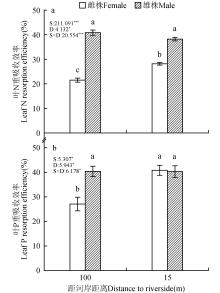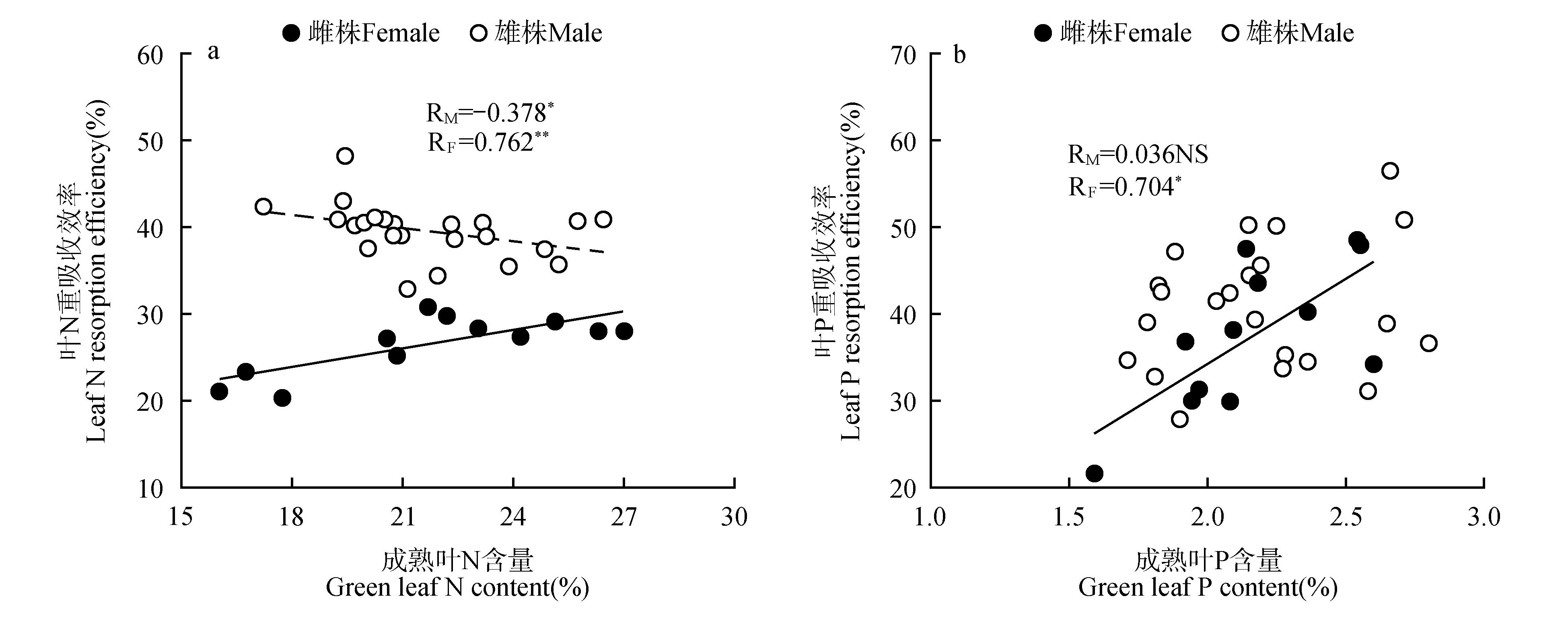Bulletin of Botanical Research ›› 2021, Vol. 41 ›› Issue (5): 789-797.doi: 10.7525/j.issn.1673-5102.2021.05.017
Previous Articles Next Articles
Xue-Mei HUANG, Yong-Hong MA, Ting-Fa DONG( )
)
Received:2020-03-12
Online:2021-09-20
Published:2021-07-05
Contact:
Ting-Fa DONG
E-mail:dongfar@163.com
About author:HUANG Xue-Mei(1995—),female,master candidate,mainly engaged in plant ecology.
Supported by:CLC Number:
Xue-Mei HUANG, Yong-Hong MA, Ting-Fa DONG. Effects of Distance to Riverside on Male and Female Plant Distribution,Plant Morphology and Leaf N-and P-resorption Efficiencies of Cercidiphyllum japonicum[J]. Bulletin of Botanical Research, 2021, 41(5): 789-797.
Add to citation manager EndNote|Ris|BibTeX
URL: https://bbr.nefu.edu.cn/EN/10.7525/j.issn.1673-5102.2021.05.017
Table 1
Plants and their soil characteristics of male and female C. japonicum in different riparian zones
性状 Trait | 距河岸距离Distance to riverside(m) | 效应F(Effect) | |||||
|---|---|---|---|---|---|---|---|
| 100 m | 15 m | 性别 Sex(S) | 河距 Distance(D) | 性别×河距 S×D | |||
| 雌株Female | 雄株Male | 雌株Female | 雄株Male | ||||
| 平均胸径Diameter at beast height(m) | 0.49±0.10 | 0.62±0.08 | 0.41±0.05 | 0.48±0.07 | 1.273NS | 1.541NS | 0.150NS |
| 平均株高Height(m) | 14.67±0.67c | 22.45±1.11a | 18.58±1.01b | 18.00±0.94b | 10.441** | 0.043NS | 7.733** |
| 土壤含水量Soil water content(%) | 48.80±1.76bc | 44.37±2.02c | 59.20±2.38a | 57.29±2.57ab | 1.150NS | 15.604*** | 0.181NS |
| 土壤N含量Soil N content(mg·g-1) | 1.83±0.06a | 1.49±0.11b | 1.78±0.07ab | 1.45±0.1b | 7.255* | 0.143NS | 0.001NS |
| 土壤P含量Soil P content(mg·g-1) | 1.51±0.06a | 0.94±0.05bc | 1.11±0.07b | 0.86±0.03c | 44.653*** | 14.895*** | 6.826* |
Table 2
Nitrogen and Phosphorus contents of green and senesensed(sen.) leaves of male and female C. japonicum in different riparian zones
性状 Trait | 距河岸距离Distance to riverside(m) | 效应F(Effect) | |||||
|---|---|---|---|---|---|---|---|
| 100 m | 15 m | 性别 Sex(S) | 河距 Distance(D) | 性别×河距 S×D | |||
| 雌株Female | 雄株Male | 雌株Female | 雄株Male | ||||
| 成熟叶N含量Green leaf N content(mg·g-1) | 16.86±0.5c | 23.00±0.7a | 19.63±0.35b | 23.37±0.56a | 45.796*** | 4.605* | 2.701NS |
| 成熟叶P含量Green leaf P content(mg·g-1) | 1.87±0.15b | 2.18±0.09b | 1.95±0.05b | 2.5±0.09a | 17.442*** | 3.685* | 1.422NS |
| 衰老叶N含量Sen. leaf N content(mg·g-1) | 14.24±0.47 | 13.65±0.55 | 15.00±0.36 | 14.42±0.35 | 0.459NP | 2.402NS | 0.007NS |
| 衰老叶P含量Sen. leaf P content(mg·g-1) | 1.36±0.06ab | 1.29±0.06ab | 1.15±0.04b | 1.50±0.09a | 2.758NS | 0.002NS | 5.786* |

Fig.1
Difference of leaf N-and P-resorption efficiencies between male and female C. japonicum in different riparian zonesS.Sex effect;D.Distance effect;S×D.Sex and Distance inactive effect;F valueis shown;Different letters indicate differences between treatments(Duncan test);*P<0.05;***P<0.001


Fig.2
Relationship of leaf N-(a,b) and N-(c,d) resorption efficiencies with their contents of green leaf N and P of female(solid circle;solid line) and male(open circle;dotted line) C. japonicumRM and RF represent the coefficient of female and male plant traits and their soil factors,respectively;NS.P>0.05;*P<0.05;***P<0.001;The same as belowt

| 1 | Naiman R J,Décamps H.The ecology of interfaces:riparian zones[J].Annual Review of Ecology and Systematics,1997,28:621-658. |
| 2 | 郭二辉,孙然好,陈利顶,等.河岸植被缓冲带主要生态服务功能研究的现状与展望[J].生态学杂志,2011,30(8):1830-1837. |
| Guo E H,Sun R H,Chen L D,et al.Main ecological service functions in riparian vegetation buffer zone:research progress and prospects[J].Chinese Journal of Ecology,2011,30(8):1830-1837. | |
| 3 | Bejarano M D,Jansson R,Nilsson C.The effects of hydropeaking on riverine plants:a review[J].Biological Reviews,2018,93(1):658-673. |
| 4 | 梁士楚,刘润红,荣春艳,等.漓江河岸带植物功能性状变异与关联[J].植物生态学报,2019,43(1):16-26. |
| Liang S C,Liu R H,Rong C Y,et al.Variation and correlation of plant functional traits in the riparian zone of the Lijiang River,Guilin,Southwest China[J].Chinese Journal of Plant Ecology,2019,43(1):16-26. | |
| 5 | Wang P Y,Liu W J,Zhang J L,et al.Seasonal and spatial variations of water use among riparian vegetation in tropical monsoon region of SW China[J].Ecohydrology,2019,12(4):e2085. |
| 6 | 蒙振思,向卫,苏国岿,等.河北小五台山青杨种群中雌雄群体的空间分布及其成因[J].植物生态学报,2018,42(12):1145-1153. |
| Meng Z S,Xiang W,Su G K,et al.Spatial distribution of male and female Populus cathayana populations and its drivers in Xiaowutai Mountains,Hebei,China[J].Chinese Journal of Plant Ecology,2018,42(12):1145-1153. | |
| 7 | Masaki T,Osumi K,Takahashi K,et al.Effects of microenvironmental heterogeneity on the seed-to-seedling process and tree coexistence in a riparian forest[J].Ecological Research,2007,22(5):724-734. |
| 8 | Hultine K R,Bush S E,West A G,et al.Population structure,physiology and ecohydrological impacts of dioecious riparian tree species of western North America[J].Oecologia,2007,154(1):85-93. |
| 9 | Singer M B,Stella J C,Dufour S,et al.Contrasting water-uptake and growth responses to drought in co-occurring riparian tree species[J].Ecohydrology,2013,6(3):402-412. |
| 10 | Freschet G T,Cornelissen J H C,Van Logtestijn R S P,et al.Substantial nutrient resorption from leaves,stems and roots in a subarctic flora:what is the link with other resource economics traits?[J].New Phytologist,2010,186(4):879-889. |
| 11 | 陆姣云,段兵红,杨梅,等.植物叶片氮磷养分重吸收规律及其调控机制研究进展[J].草业学报,2018,27(4):178-188. |
| Lu J Y,Duan B H,Yang M,et al.Research progress in nitrogen and phosphorus resorption from senesced leaves and the influence of ontogenetic and environmental factors[J].Acta Prataculturae Sinica,2018,27(4):178-188. | |
| 12 | Lü X T,Freschet G T,Flynn D F B,et al.Plasticity in leaf and stem nutrient resorption proficiency potentially reinforces plant-soil feedbacks and microscale heterogeneity in a semi-arid grassland[J].Journal of Ecology,2012,100(1):144-150. |
| 13 | Lü X T,Han X G.Nutrient resorption responses to water and nitrogen amendment in semi-arid grassland of Inner Mongolia,China[J].Plant and Soil,2010,327(1-2):481-491. |
| 14 | Xu X,Peng G Q,Wu C C,et al.Drought inhibits photosynthetic capacity more in females than in males of Populus cathayana[J].Tree Physiology,2008,28(11):1751-1759. |
| 15 | Zhang S,Jiang H,Zhao H X,et al.Sexually different physiological responses of Populus cathayana to nitrogen and phosphorus deficiencies[J].Tree Physiology,2014,34(4):343-354. |
| 16 | Hultine K R,Grady K C,Wood T E,et al.Climate change perils for dioecious plant species[J].Nature Plants,2016,2(8):16109. |
| 17 | 马文宝,廖成云,姬慧娟,等.濒危连香树种群性比和雌雄株功能性状的差异[J].生态学杂志,2019,38(8):2414-2419. |
| Ma W B,Liao C Y,Ji H J,et al.Sex ratio and sexual difference of functional traits in the endangered plant Cercidiphyllum japonicum[J].Chinese Journal of Ecology,2019,38(8):2414-2419. | |
| 18 | Kubo M,Sakio H,Shimano K,et al.Factors influencing seedling emergence and survival in Cercidiphyllum japonicum[J].Folia Geobotanica,2004,39(3):225-234. |
| 19 | Kubo M,Sakio H,Shimano K,et al.Age structure and dynamics of Cercidiphyllum japonicum sprouts based on growth ring analysis[J].Forest Ecology and Management,2005,213(1-3):253-260. |
| 20 | 潘开文,刘照光.用关联度和聚类分析法研究连香树人工群落与环境的关系[J].应用生态学报,2001,12(2):161-167. |
| Pan K W,Liu Z G.Grey correlation and cluster analysis on relationship between Cercidiphyllum japonicum community and its environment[J].Chinese Journal of Applied Ecology,2001,12(2):161-167. | |
| 21 | Sato T,Isagi Y,Sakio H,et al.Effect of gene flow on spatial genetic structure in the riparian canopy tree Cercidiphyllum japonicum revealed by microsatellite analysis[J].Heredity,2006,96(1):79-84. |
| 22 | 何东,魏新增,李连发,等.神农架山地河岸带连香树的种群结构与动态[J].植物生态学报,2009,33(3):469-481. |
| He D,Wei X Z,Li L F,et al.Population structure and dynamics of Cercidiphyllum japonicum in riparian zones of the Shennongjia Mountainous region,central China[J].Chinese Journal of Plant Ecology,2009,33(3):469-481. | |
| 23 | Sakio H,Kubo M,Shimano K,et al.Coexistence of three canopy tree species in a riparian forest in the Chichibu Mountains,central Japan[J].Folia Geobotanica,2002,37(1):45-61. |
| 24 | Killingbeck K T.Nutrients in senesced leaves:keys to the search for potential resorption and resorption proficiency[J].Ecology,1996,77(6):1716-1727. |
| 25 | Brant A N,Chen H Y H.Patterns and mechanisms of nutrient resorption in plants[J].Critical Reviews in Plant Sciences,2015,34(5):471-486. |
| 26 | Dong T F,Li J Y,Zhang Y B,et al.Partial shading of lateral branches affects growth,and foliage nitrogen- and water-use efficiencies in the conifer Cunninghamia lanceolata growing in a warm monsoon climate[J].Tree Physiology,2015,35(6):632-643. |
| 27 | Zhang R,Liu J Y,Liu Q S,et al.Sexual differences in growth and defence of Populus yunnanensis under drought stress[J].Canadian Journal of Forest Research,2019,49(5):491-499. |
| 28 | Olano J M,González-Muñoz N,Arzac A,et al.Sex determines xylem anatomy in a dioecious conifer:hydraulic consequences in a drier world[J].Tree Physiology,2017,37(11):1493-1502. |
| 29 | Vergutz L,Manzoni S,Porporato A,et al.Global resorption efficiencies and concentrations of carbon and nutrients in leaves of terrestrial plants[J].Ecological Monographs,2012,82(2):205-220. |
| 30 | Li D D,Dong T F,Zhang C Y,et al.Effects of elevated temperature and CO2 concentration on floral development and sex differentiation in Morus alba L.[J].Annals of Forest Science,2019,76(4):112. |
| 31 | Minoletti M L,Boerner R E J.Drought and site fertility effects on foliar nitrogen and phosphorus dynamics and nutrient resorption by the forest understory shrub Viburnum acerifolium L.[J].The American Midland Naturalist,1994,131(1):109-119. |
| 32 | Aerts R.Nutrient resorption from senescing leaves of perennials:are there general patterns?[J].Journal of Ecology,1996,84(4):597-608. |
| 33 | Zhang Y J,Yang Q Y,Lee D W,et al.Extended leaf senescence promotes carbon gain and nutrient resorption:importance of maintaining winter photosynthesis in subtropical forests[J].Oecologia,2013,173(3):721-730. |
| 34 | Dawson T E,Ehleringer J R.Gender-specific physiology,carbon isotope discrimination,and habitat distribution in boxelder,Acer negundo[J].Ecology,1993,74(3):798-815. |
| 35 | 张玲,张东来.基于形态学及生理学的黄檗性别差异研究[J].植物研究,2019,39(6):876-882. |
| Zhang L,Zhang D L.Difference in morphology and physiology from male and female plant of Phellodendron amurense Rupr.[J].Bulletin of Botanical Research,2019,39(6):876-882. | |
| 36 | Delph L F,Meagher T R.Sexual dimorphism masks life history trade-offs in the dioecious plant Silene latifolia[J].Ecology,1995,76(3):775-785. |
| [1] | Xinyu NI, Junying HE, Mengjiao YAN, Chao DU. Application Progress of RNA-Seq Technology in Rare and Endangered Plants [J]. Bulletin of Botanical Research, 2023, 43(4): 481-492. |
| [2] | XIAO Zhi-Peng, YIN Chong-Min, GUO Lian-Jin, WU Yuan-Rong, HU Jin-Ping, LIU Yan-Yan, ZHONG You-Chun, XUE Ping-Ping. Effect of Light Quality on Seed Germination and Seeding Growth of Emmenopterys henryi [J]. Bulletin of Botanical Research, 2020, 40(2): 189-195. |
| [3] | GUAN Rui-Ting, LIU Ji-Ming, WANG Min, CHEN Jing-Zhong, WU Meng-Yao, TONG Bing-Li. Genetic Diversity of Critically Endangered Plants Petrocalamus luodianensis from Different Natural Populations [J]. Bulletin of Botanical Research, 2019, 39(5): 740-751. |
| [4] | WAN Xue-Bing, WANG Qing-Gui, YAN Guo-Yong, XING Ya-Juan. Response of Ecological Stoichiometric Characteristics and Photosynthetic Characteristics of Plant Leaves to Long-term N Deposition in Natural Secondary Forest [J]. Bulletin of Botanical Research, 2019, 39(3): 407-420. |
| [5] | SUN Ye-gen. FLORISTIC ANALYSIS OF THE RARE AND ENDANGERED PLANTS IN ANHUI PROVINCE [J]. Bulletin of Botanical Research, 2000, 20(1): 20-26. |
| [6] | Sun Qi-Shi. GEOGRAPHIC DISTRIBUTION AND ITS FLORISTIC CHARACTERISTICS OF THE RARE, ENDANGERED AND PROTECTED PLANTS IN N.E-CHINA [J]. Bulletin of Botanical Research, 1995, 15(4): 485-490. |
| Viewed | ||||||
|
Full text |
|
|||||
|
Abstract |
|
|||||